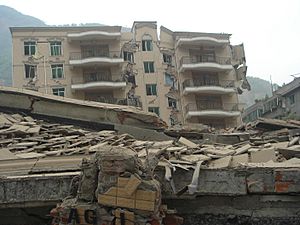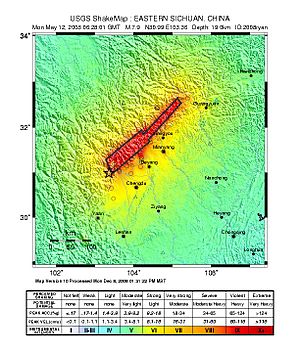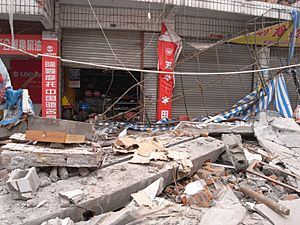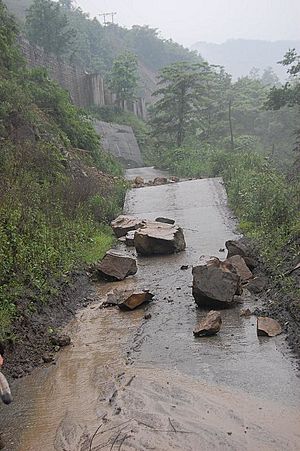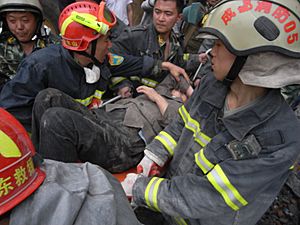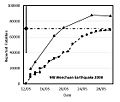2008 Sichuan earthquake facts for kids
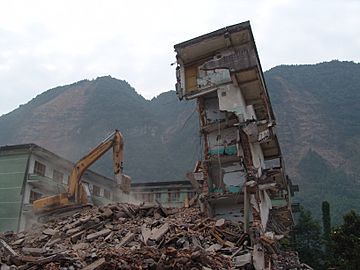
A collapsed residential block in Wenchuan being bulldozed in the aftermath of the earthquake; exposed mountain faces can be seen in the background.
|
|
| UTC time | 2008-05-12 06:28:01 |
|---|---|
| ISC event | 13228121 |
| USGS-ANSS | ComCat |
| Local date | 12 May 2008 |
| Local time | 14:28:01 CST |
| Duration | >2 minutes |
| Magnitude | 8.0 Ms, 7.9 Mw |
| Depth | 19 km (12 mi) |
| Epicenter | 31°01′16″N 103°22′01″E / 31.021°N 103.367°E |
| Fault | Longmenshan Fault |
| Type | Thrust fault |
| Areas affected | Sichuan |
| Total damage | $150 billion USD |
| Max. intensity | XI (Extreme) |
| Aftershocks | 149 to 284 major, over 42,719 total |
| Casualties |
|
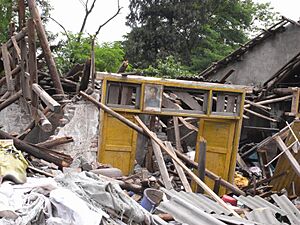
The 2008 Sichuan earthquake (Chinese: 四川大地震) was a very powerful earthquake that hit China on May 12, 2008. It caused a lot of damage and sadness. Thousands of people died, and many more were injured or went missing. Millions of people lost their homes when buildings collapsed. The earthquake was so strong that it could be felt far away, even in other countries.
Contents
What Caused the Sichuan Earthquake?
The Earth's surface is made of huge pieces called plates. These plates are always moving, very slowly. The Sichuan earthquake happened because the Indian plate is pushing north into the Eurasian plate. This pushing motion has created the huge Himalaya mountains. It also causes the ground in Sichuan and southern China to get squeezed. This squeezing builds up a lot of pressure, which can lead to earthquakes.
The earthquake's center was in the mountains on the edge of the Qing-Tibet Plateau. This area is near the Longmenshan Fault, a long crack in the Earth's crust. The earthquake happened when parts of this fault suddenly slipped.
How Strong Was the Earthquake?
The earthquake was measured as an 8.0 on the Ms scale and 7.9 on the Mw scale. It happened at 2:28 PM local time. The earthquake's starting point, called the epicenter, was about 19 kilometres (12 mi) deep underground.
The shaking lasted for about two minutes. It was very powerful because it was not very deep. This meant the shock waves had a lot of energy when they reached the surface. Many people lived right above the epicenter, which led to more casualties. The strong ground in central China also helped the shock waves travel long distances without losing much power.
The earthquake was felt in many cities far away. People in Beijing, 1,500 kilometres (932 mi) away, and Shanghai, 1,700 kilometres (1,056 mi) away, felt their tall buildings shake. The tremors were also felt in nearby countries.
Aftershocks
After the main earthquake, there were many smaller quakes called aftershocks. Within 72 hours, 52 large aftershocks were recorded. These ranged in size from 4.4 to 6.0 magnitude. Overall, there were more than 42,719 aftershocks.
Where the Shaking Was Felt
The earthquake's tremors were felt in many places:
 China: Almost all parts of China felt the quake, except for Xinjiang, Jilin, and Heilongjiang.
China: Almost all parts of China felt the quake, except for Xinjiang, Jilin, and Heilongjiang. Hong Kong: Tremors were felt about 3 minutes after the quake and lasted for 30 seconds.
Hong Kong: Tremors were felt about 3 minutes after the quake and lasted for 30 seconds. Macau: Tremors were also felt about 3 minutes after the quake.
Macau: Tremors were also felt about 3 minutes after the quake. Vietnam: Northern Vietnam felt tremors about 5 minutes after the earthquake.
Vietnam: Northern Vietnam felt tremors about 5 minutes after the earthquake. Thailand: Parts of Thailand felt tremors 6 minutes after the quake. Office buildings in Bangkok shook for several minutes.
Thailand: Parts of Thailand felt tremors 6 minutes after the quake. Office buildings in Bangkok shook for several minutes. Taiwan: It took about 8 minutes for the quake to reach Taiwan, and the tremors lasted for nearly 2 minutes.
Taiwan: It took about 8 minutes for the quake to reach Taiwan, and the tremors lasted for nearly 2 minutes. Mongolia: Tremors were felt about 8 minutes after the earthquake.
Mongolia: Tremors were felt about 8 minutes after the earthquake. Bangladesh: Tremors were felt 8 and a half minutes after the quake.
Bangladesh: Tremors were felt 8 and a half minutes after the quake. Nepal: Tremors were felt about 8 and a half minutes after the quake.
Nepal: Tremors were felt about 8 and a half minutes after the quake. India: Parts of India felt tremors about 9 minutes after the earthquake.
India: Parts of India felt tremors about 9 minutes after the earthquake. Pakistan: In Northern Pakistan, tremors were felt 10 minutes after the quake.
Pakistan: In Northern Pakistan, tremors were felt 10 minutes after the quake. Russia: Tremors were felt in Tuva, Russia.
Russia: Tremors were felt in Tuva, Russia.
Immediate Impact and Damage
When the earthquake hit, people in many cities reacted quickly. Office buildings in Shanghai, including very tall ones like the Jin Mao Tower, were evacuated. This means everyone was told to leave for safety. The Chengdu airport was shut down, and some flights were sent to other cities. Later, Chengdu airport reopened to help with rescue efforts.
In Beijing, many office buildings were also evacuated. Even the media offices for the 2008 Summer Olympics were emptied, but none of the Olympic venues were damaged. A train carrying petrol tanks derailed in Gansu Province because the earthquake twisted the railway tracks, causing a fire.
Roads leading into Wenchuan, the area closest to the epicenter, were badly damaged. This made it very hard for rescue teams to reach people. In Beichuan county, 80% of the buildings collapsed. Two chemical factories in Shifang were damaged and leaked 80 tons of liquid ammonia, which is dangerous.
The Dujiangyan Irrigation System, an ancient water system and a UNESCO World Heritage Site, was also damaged. This system is still used today.
Communication and Power Loss
Half of the wireless communication in Sichuan province was lost. Phone companies like China Mobile and China Unicom had many base stations (phone towers) out of service. This happened because of power outages and too many people trying to make calls at once.
Dams and Lakes
The Zipingpu hydro power station, about 20 kilometres (12 mi) from the epicenter, was badly damaged. Its dam wall cracked, and buildings collapsed. Other dams were also in danger. Troops were sent to try and release pressure from the dams. In total, 391 dams were damaged by the earthquake.
By May 18, 2008, 21 new lakes had formed in Sichuan. This happened because the earthquake caused landslides that blocked rivers. Villages had to be evacuated because of the risk of flooding from these new lakes.
Impact on Animals
Two pandas at a Giant Panda reserve were injured, and two others went missing after the earthquake.
Casualties and School Collapses
The earthquake was one of the deadliest in China's history. The Chinese government reported that 69,181 people were killed, with most deaths in Sichuan province. There were 18,498 people listed as missing and 374,171 people injured. About 4.8 million people were left homeless.
In Yingxiu, a rescue team found only 2,300 people alive out of about 9,000 who lived there before the quake. In Beichuan county, 3,000 to 5,000 people died, and 10,000 were injured.
Schools and Students
One of the most tragic parts of the earthquake was the collapse of many schools. Thousands of school children died because their school buildings were badly built. At least 7,000 school buildings collapsed. For example, at Juyuan Elementary School, at least 600 students and staff died. Up to 1,300 children and teachers died at Beichuan Middle School.

Many parents were very upset because other buildings nearby did not collapse. They believed the government and builders did not construct the schools properly. Parents protested and asked for an investigation. The government tried to stop news about the poorly built schools from being published.
A teacher named Liu Shaokun was arrested for spreading "rumors" after he took photos of collapsed schools and shared them online. He was later released but had to serve a sentence outside of a labor camp. After the earthquake, China began safety checks at schools across the country. New laws were made to improve building standards for schools, especially in rural areas.
Rescue Efforts and Help
China's President Hu Jintao and Premier Wen Jiabao quickly went to the earthquake area to organize rescue work. The Ministry of Health sent emergency medical teams. The military sent 50,000 troops and police to help.
Getting help to the affected areas was very difficult because of the mountains. Roads were damaged and blocked by landslides. Rescue teams had to walk for days, carrying supplies like tents, medicine, water, and food. One group of 80 men carried 40 kilograms (88 lb) of supplies each to reach a village 4,000 metres (13,123 ft) above sea level.
Heavy rain and more landslides made rescue efforts even harder. Helicopters were used to deliver aid and carry injured people. Within two days, phones in the main town of Wenchuan were being fixed. Soldiers even parachuted into hard-to-reach areas.
Three days after the quake, China used 150 aircraft for relief work. This was China's largest ever non-combat airlifting operation. People all over China donated money and blood to help the victims.
International Support
China welcomed help from other countries. The Tzu Chi Foundation from Taiwan was one of the first international groups to arrive on May 13. They sent 100 tons of relief supplies.
Many countries sent rescue teams and aid. Rescue groups from South Korea, Japan, Singapore, Russia, and Taiwan arrived by May 16. The United States shared satellite images of the damaged areas and sent two large cargo planes with supplies like tents and generators.
The International Federation of the Red Cross praised China's quick and efficient rescue efforts. They noted that the disaster was so huge that no single government could handle everything alone.
Internet and National Mourning
The Internet played a big role in helping with rescue and recovery. Official news agencies set up online centers for rescue requests. Volunteers created websites to share contact information for victims.
To show sadness for the victims, the Chinese government declared three days of national mourning starting on May 19, 2008. This was the first time China had national mourning days for something other than the death of a state leader. The Chinese National Flag was flown at half-mast.
At 2:28 PM on May 19, exactly one week after the earthquake, people across China held a moment of silence for three minutes. Cars stopped, and sirens sounded. After the silence, crowds in Tiananmen Square shouted "Long Live China."
The 2008 Summer Olympics torch relay was stopped for three days. Chinese websites changed their pages to black and white, and many removed advertisements. Video sharing sites only showed earthquake-related videos. TV stations also showed non-stop earthquake coverage and removed commercials. A special TV show called The Giving of Love raised about 1.5 billion Chinese Yuan (about US$208 million) for the victims.
Images for kids
See also
 In Spanish: Terremoto de Sichuan de 2008 para niños
In Spanish: Terremoto de Sichuan de 2008 para niños


